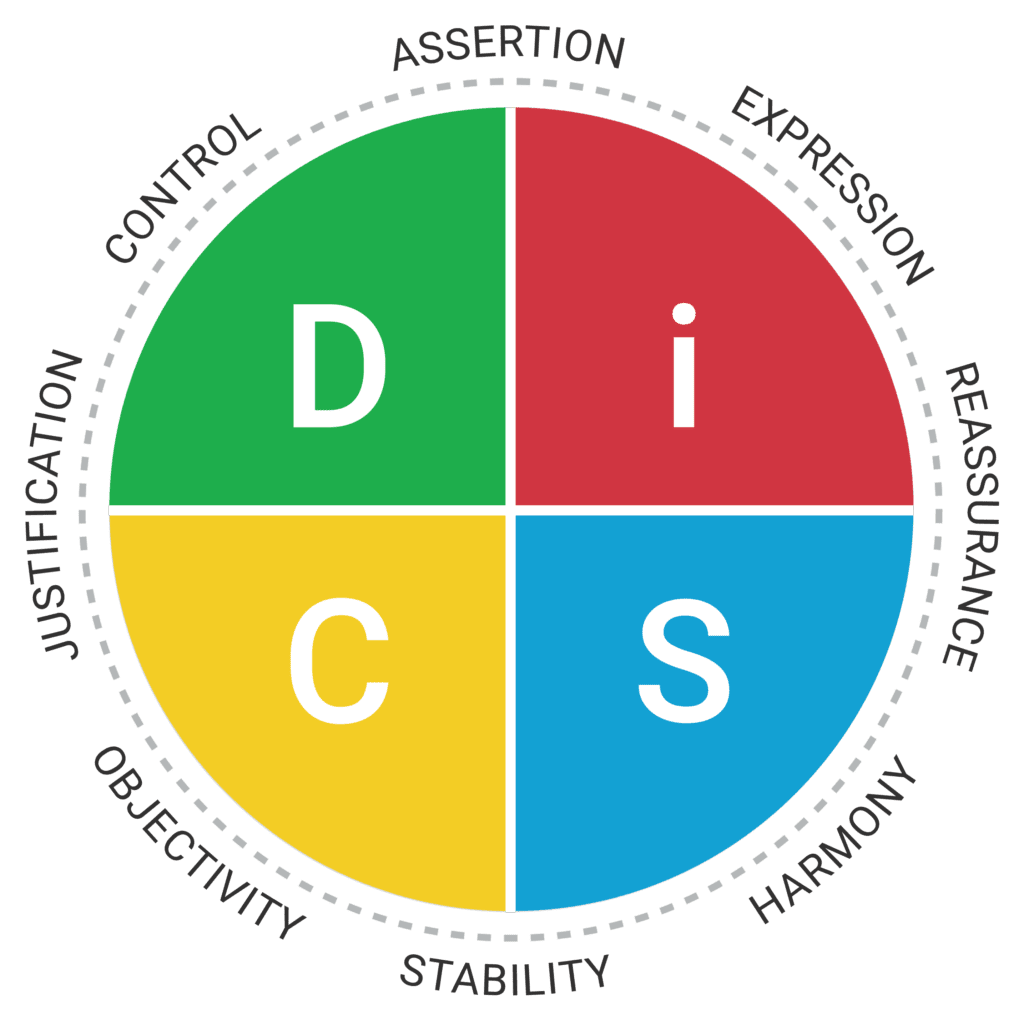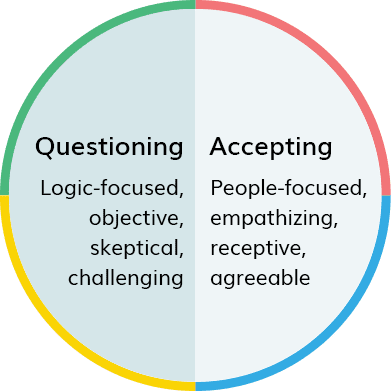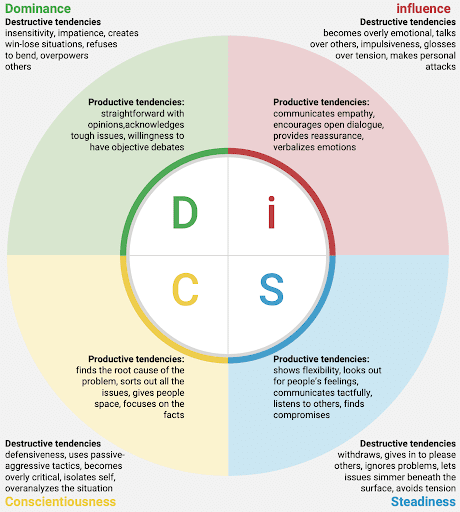3 ways DiSC can help you deal with difficult people

Dealing with difficult people occurs in everyone’s life.
So, what do you do when you are with someone who irks you?
One way to deal with difficult people is to use Everything DiSC to decode that person’s personality.
DiSC can provide immediate insights into why two people butt heads. DiSC measures certain behavioral traits and offers insights into a person’s personality. It will outline how two individuals are different based on their behaviors and it can help them have a conversation to meet in the middle.
Here’s how DiSC can help you engage better with a difficult person:
- Discover your personality style and why your priorities might not match the other person who you have difficulties with
- Use DiSC to have a judgment-free conversation about personality differences
- Recognize how automatic thoughts interfere with our behavior
Before we dive into this article, please note that DiSC is not a solution for behavioral problems that go beyond personality differences. Issues like addiction, depression, or other mental health issues should be always identified and actively treated before using a tool like DiSC.
For issues that stem from personality differences, DiSC will help bridge the divide between two employees who are having issues.
Use DiSC to understand personality differences with difficult people

Difficult peoples often exist because their personality doesn’t match with our own.
Personality has been researched since at least the Ancient Greeks. Hippocrates outlined how you could categorize people into four distinct categories. What we have found since the early 1920s is that a person’s personality is largely based on how they behave.
Everything DiSC is an assessment that measures behavioral preferences. Our behavioral preferences become how others understand our personality.
DiSC measures two behavioral preferences:
- Does a person take risks, move at a quicker pace, or choose to be in environments that are constantly changing and in motion? Or, are they risk-averse and prefer stability over change.
- Does a person prefer to work on their own or with others? When presented with a task, do they focus solely on the task at hand or do they look to find ways others can be involved in the task?


Try to learn your style:
An Everything DiSC assessment contains over 100 different questions but uses an algorithmic approach to which questions are asked.
You can start to discover your own style by asking yourself these questions and identifying your ‘core’ style. If you find that you are both ‘Questioning‘ and ‘Active‘ you would have the D personality type and your style would be in the top, left quadrant. If you were the opposite of those two behavioral preferences (‘Accepting‘ and ‘Thoughtful‘) you would have the S personality type located in the bottom right corner of the quadrant.
A person will receive one or a combination of the four DiSC Styles:
- D Personality Type / Dominance: Direct, tough-minded, strong-willed
- i Personality Type / Influence: Outgoing, enthusiastic, optimistic
- C Personality Type / Conscientiousness: Analytical, reserved, precise
- S Personality Type / Steadiness: Even-tempered, accommodating, patient
The results from a person’s assessment are easy and simple to understand. When trying to navigate dealing with difficult people, a DiSC assessment provides insights into why someone might engage in destructive tendencies that make them difficult to deal with.
Learn why someone is being difficult with DiSC:
As an example, when a person with the D personality type, could become both defensive and insensitive when they feel themselves entering into a conflict situation with someone else.
Their personality style pushes them to show their confidence. They will assert their views often. They have a strong sense of how things should be done, and this could easily make them difficult to work with. When they are challenged they will try to overpower whoever is challenging them or create win-loose situations.
For both individuals with this style and for anyone who works with a person who has this style, it’s important to recognize these characteristics and know how to engage with them.
Everything DiSC Productive Conflict provides these insights into ourselves and others. It can help us deal with difficult people more easily because it will help us identify our preferences and the preferences of others.
It will first help a person understand what their natural style is when they are in a tense situation. It will help them identify and understand why their difficult co-worker is behaving the way they are, and it will then help them navigate how to approach them in the future.
Use DiSC to have judgment-free conversations with difficult people
Often, the power of DiSC is misunderstood. It’s an incredible tool to help someone identify insights about themselves and others. However, the true power of DiSC over tools like Myers-Briggs is that it provides a natural medium for having conversations about personality.
It’s easier to discuss our own behavior or someone else’s behavior with DiSC because the model, while very simple, packs a lot of information.
A person with the D Style is able to make a statement like;
“As you know, I have a D-Style. I don’t want you to feel micro-managed, but I want to make sure we are moving things forward. Can you give me updates on your progress?”
In this instance, someone used DiSC to:
- Explain that they have a strong desire to be in control and move things forward
- Recognize that their strong will could be overwhelming.
In a few words, they explained their preferred work priorities. When we use DiSC in this manner, it can open up a conversation about what everyone needs.
The language can work from the other person’s perspective as well. Someone who is working with an individual with the D-Style could say something like this:
"I know you wanted to wrap this all up today. However, I want to make sure what we are working on is accurate. I will give you an update tomorrow so you will know I’m working to get this done on time.”
In this example, they used their knowledge of the D-Style to meet their colleague halfway. They acknowledge the needs of their co-worker (getting things done and being in control) and advocated for their own needs (making sure the project was accurate).
In both of these examples, two individuals are able to talk about needs without feeling judged or awkward. DiSC allows for these types of conversations.
However, you might have encountered situations that don’t seem to fall within identifiable DiSC behavior. Have you worked with a difficult person who became enraged, defensive, or sarcastic?
Potentially, the behavior resembles more of an emotional response. A person might raise their voice over yours, try to belittle you, or become dramatic. What do you do then?
Identify automatic thoughts and responses of difficult people
Everyone has automatic thoughts that we can’t control. At times, these thoughts push us to behave aggressively, defensively, or even manipulatively.
Dealing with these thoughts is one of the primary goals of the Everything DiSC Productive Conflict training program and individual assessment.
When a situation becomes tense, it’s these thoughts that will turn a tense discussion into a destructive situation. These automatic thoughts become our go-to responses when we feel threatened or when our emotions are heightened.
It’s natural to protect ourselves. Our automatic thoughts and responses developed from the sense to protect ourselves.
Humans developed the ability to react immediately to save themselves centuries ago from a predator, storm, or some other natural disaster. The term ‘fight or flight’ often describes this type of thinking.
Today, our environment is much less dangerous. The wild and hostile environment humans evolved from was replaced with the office. Unfortunately, we still have our knee-jerk reactions based on automatic thinking.
These reactions are grounded in the same level of thinking as ‘fight or flight’ but they are now coming from a social sense.
As an example, ‘fighting’ becomes raising your voice over someone else. Taking ‘flight’ becomes pointing the finger at someone else for an issue with a project you were part of.
Perhaps you have encountered a difficult person engaging in this type of behavior.
Here are a few of these automatic thoughts and destructive responses:

Automatic Thought: Defensiveness
- Becoming protective in the face of criticism
When our failures or shortcomings are identified the automatic thought of defensiveness could potentially surface. If we believe we are in a high-stakes situation we might choose to cover up any perceived vulnerabilities or weaknesses rather than admit to them. This will especially happen with individuals who we don’t trust.
This automatic thought is more mild compared to more aggressive ones. However, it can compound into larger issues. If someone never accepts that they make errors, it can cause others to avoid talking to them about the errors. This can lead to greater divides on teams or in relationships.
Here is how the automatic thought might arise:

Automatic Thought: Exaggerating
- Representing something as being worse than it actually isdeal with
This automatic thought occurs as a way to justify the intensity of our emotions. It’s a way of making a situation sound as bad as it feels. Exaggeration empowers us. It can act as a coping mechanism to help us justify why we are feeling the way we are feeling.
What we gain from this emotional empowerment, we lose from a conversation. We allow small issues to turn into massive events rather than just moving on. We don’t allow ourselves to grow through our mistakes. Essentially, we shuffle them away until they come back to haunt us again and again.
Here is how this automatic thought and response might look:
Don't become a difficult person: How to identify automatic thoughts
So what can we do to change a difficult person when they engage in this type of behavior?
Not much, honestly.
However, we can control our own behavior in response to how they act. There is an old saying that we can easily rephrase to describe difficult people. It goes like this:
There are only three ways to improve a difficult relationship:
- You can change the person.
- You can leave.
- You can change yourself.
Option #1 is impossible. As much as we believe we can change someone’s thinking, it is only their choice to change.
Option #2 is a valid option, and there are many instances where this is the best option. However, for many difficult relationships, this might only be a temporary solution. You can only avoid a difficult person at work for so long.
Option #3 is the most consistently successful option. If we are able to manage our own behaviors, even in the face of someone who is acting like a jerk, we have a better chance of improving the situation.
While it’s easy to talk about the automatic thoughts of our difficult co-workers we need to look inwards at our own automatic thoughts and find a way to deal with them.
First, pause. Then reframe.
So, how do we manage our own automatic thoughts?
We will never be able to fully stop knee-jerk reactions. It’s part of who we are as humans and how our brains are wired.
However, we can manage those reactions and withhold many of them. To do this requires a simple process. The next time you feel that you might deliver an emotional response take these steps:
- Pause. Take a deep breath.
- Ask yourself: “Is this thought valid or true? Am I overreacting?”
- Reframe your automatic thought
This simple process is outlined in a theoretical situation below:
When someone says something that is upsetting or causes you anger, you won’t be able to control the immediate thought that comes into your head. However, you can control your reaction if you pause before you respond.
This process was developed within a therapy called Cognitive Behavioral Therapy (CBT), and it’s part of the learning process of the Everything DiSC Productive Conflict assessment and training program.





